Mentorship and networking programs are essential for connecting deaf professionals, helping you build inclusive careers and access new opportunities. These programs offer cultural awareness, guidance on communication strategies, and role models to inspire growth. They foster confidence, resilience, and expand your professional network. Innovative technology and accessible events make it easier to connect across regions and barriers. Keep exploring to discover more about how these initiatives can support your career journey and long-term success.
Key Takeaways
- Mentorship programs provide deaf professionals with role models, guidance, and opportunities for leadership development.
- Digital platforms and virtual events facilitate accessible networking across regions and remove physical barriers.
- Sign language workshops and captioned events foster inclusive communication and stronger community connections.
- Industry-specific networking events enable mentorship relationships and exposure to emerging trends and opportunities.
- Peer support networks promote collaboration, emotional resilience, and career growth within the deaf professional community.
The Importance of Mentorship for Deaf Professionals

Mentorship plays an essential role in empowering deaf professionals to navigate their careers confidently. A strong mentor helps you develop cultural awareness, which is critical for understanding diverse workplace dynamics and advocating for yourself. Through guidance, you gain insights into effective communication strategies and workplace norms specific to the deaf community. Mentorship also accelerates leadership development, providing you with role models who inspire and challenge you to grow. By observing their experiences, you learn how to overcome obstacles and seize opportunities. This support system nurtures your confidence, helping you build resilience and expand your professional network. Additionally, understanding the evolving landscape of AI-related job opportunities can open new pathways for career advancement. Fostering mentorship programs within your industry can further enhance these benefits, creating a more inclusive environment for all professionals. Moreover, cultivating professional resilience through mentorship can help deaf professionals adapt to changing workplace demands. Building industry-specific knowledge is also crucial for staying competitive and informed about trends that influence career growth. Overall, mentorship is an indispensable tool for deaf professionals seeking to thrive and lead in their fields, especially as organizations increasingly recognize the importance of inclusive communication and supportive networks.
Building Inclusive Networking Opportunities
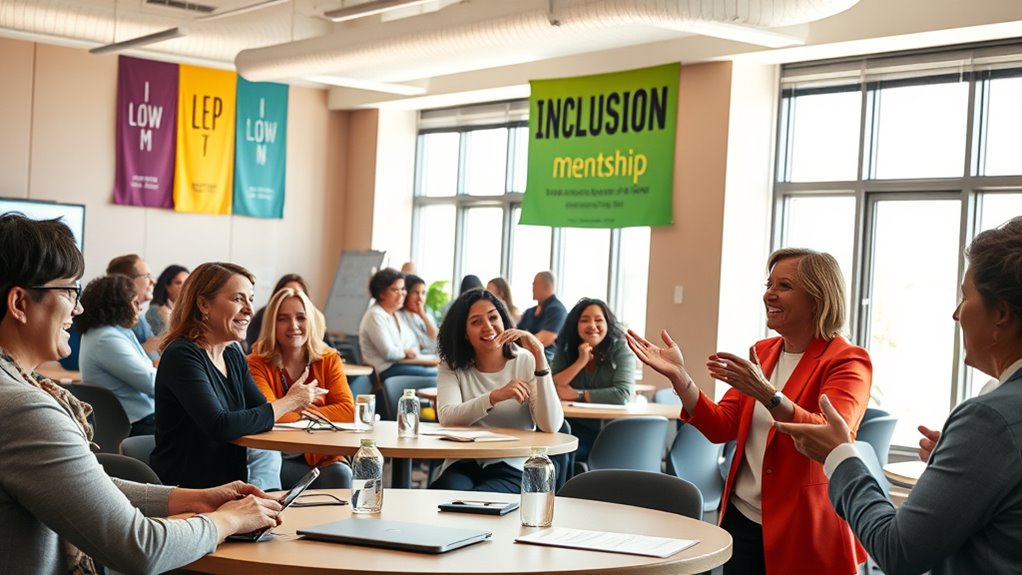
To create truly inclusive networking opportunities, consider hosting sign language workshops that break down communication barriers. Digital platforms also offer accessible spaces where everyone can connect comfortably, regardless of location or hearing ability. Sign language training can significantly enhance understanding and interaction among participants. Incorporating remote hackathons can further expand access and foster collaboration among deaf professionals across different regions. Additionally, providing captioning services during events can ensure all participants stay informed and engaged throughout the sessions. Emphasizing powerful persuasive words can also help facilitate more engaging and effective communication in these inclusive settings. Utilizing nutritional insights from apple juice and other health-promoting fruit juices as conversation starters can foster camaraderie and shared interests among attendees.
Sign Language Workshops
Hosting sign language workshops can considerably enhance inclusivity within networking events by breaking down communication barriers. By learning sign language, you create a space where deaf professionals can actively participate and share ideas through visual communication. These workshops empower attendees to develop essential skills that facilitate more meaningful interactions. When everyone understands sign language basics, you foster a more welcoming environment, encouraging diverse connections. Visual communication becomes a bridge, making conversations more accessible and engaging for deaf participants. Plus, these workshops demonstrate your commitment to inclusivity, inspiring others to follow suit. Ultimately, integrating sign language into your networking events helps build stronger, more connected professional communities where everyone’s voice can be heard and valued.
Digital Networking Platforms
Digital networking platforms offer a powerful way to create more inclusive networking opportunities by removing geographical and physical barriers. You can connect with deaf professionals worldwide through online forums, where discussions foster shared experiences and advice. Virtual reality takes this further, enabling immersive environments that simulate in-person interactions, making meetings more engaging. These platforms break down communication obstacles, providing real-time captioning and sign language options. You can participate in mentorship programs, join industry-specific groups, or attend virtual events seamlessly. This accessibility encourages diverse connections and collaboration, expanding your professional network without leaving your space. Resources and Tools play a crucial role in supporting effective communication and engagement in these digital spaces, especially when they include features that support inclusive communication. Additionally, implementing assistive technologies can further enhance interaction and understanding among participants. Incorporating accessible features such as customizable interfaces and visual cues can improve user experience and foster a more welcoming environment. Furthermore, integrating AI-powered translation tools can improve communication accuracy and efficiency, making these platforms even more accessible and effective for all users.
Overcoming Barriers Through Support Programs
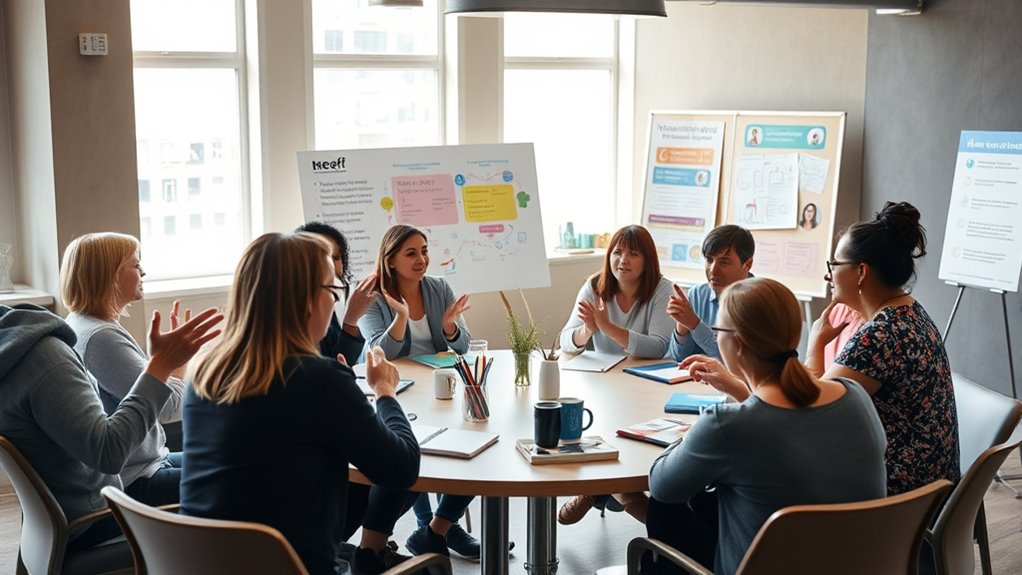
Support programs play an essential role in helping individuals overcome barriers that might otherwise hinder their progress. These programs address challenges like language barriers and cultural differences, creating a more inclusive environment. They often provide: 1. Language interpretation services to facilitate communication 2. Cultural competency training to foster understanding 3. Peer support groups for shared experiences 4. Resources tailored to specific community needs. Additionally, they may offer effective training techniques that empower individuals with practical skills to succeed in diverse settings. Incorporating residency requirements strategies can further support adaptability and personalized assistance within these initiatives. Ensuring that program content aligns with nutritional guidelines can enhance overall effectiveness and participant well-being. Recognizing the importance of inclusive practices can significantly enhance the effectiveness of these programs and promote greater community engagement. Incorporating residency requirements strategies can further support adaptability and personalized assistance within these initiatives.
Successful Mentorship Models in Practice
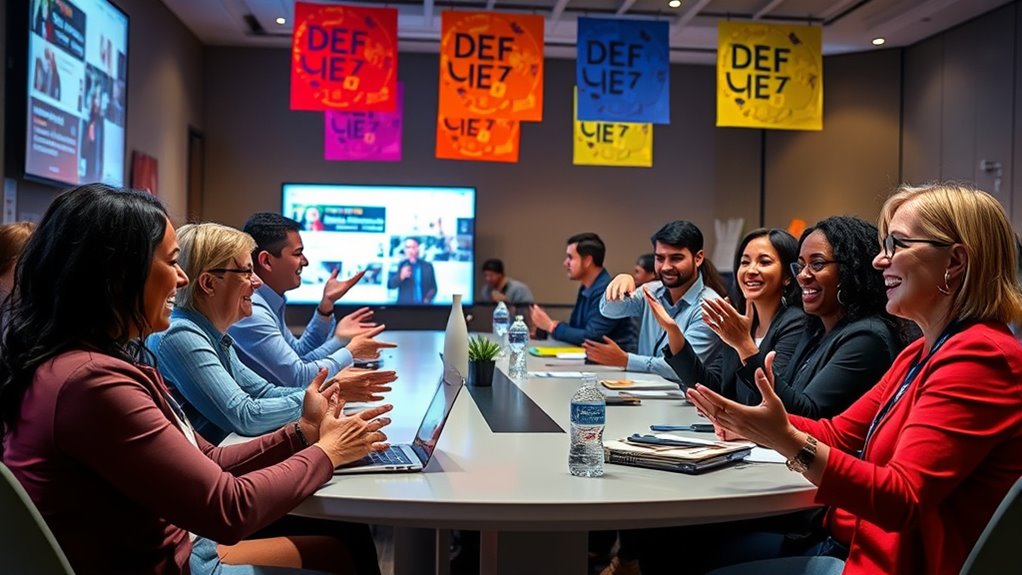
You can see success through peer-led mentoring, where colleagues support each other’s growth directly. Industry-specific networking events also create valuable connections that lead to mentorship opportunities. Exploring these models helps you understand how effective mentorship truly works in practice. Additionally, leadership skills can significantly influence the effectiveness and reach of mentorship programs, further strengthening professional relationships and career stability.
Peer-Led Mentoring Strategies
Peer-led mentoring models have gained recognition for their effectiveness in fostering meaningful development and engagement among participants. These models thrive on peer support and informal guidance, creating a comfortable environment for learning. To maximize success, consider these strategies:
- Encourage open communication, allowing mentees to share experiences freely.
- Promote mutual learning, where both mentor and mentee grow from each other’s insights.
- Foster trust through consistent, informal interactions that build rapport.
- Provide opportunities for shared projects or activities, strengthening peer support networks.
- Incorporate low light office plants to create a more inviting and calming environment that can enhance focus during mentoring sessions. Additionally, understanding congenital deafness can help mentors tailor their approach to better support deaf professionals’ unique needs.
This approach helps deaf professionals connect authentically, enhancing confidence and knowledge. Peer-led mentoring leverages the strengths of community-driven support, making mentorship accessible and relatable. When executed well, it creates a sustainable, empowering environment for ongoing growth.
Industry-Specific Networking Events
Industry-specific networking events serve as powerful platforms for fostering mentorship relationships that translate into tangible career growth. As a deaf professional, attending these events helps you connect with others who understand the importance of assistive technology, ensuring effective communication. These gatherings also promote cultural awareness, creating a more inclusive environment where diverse experiences are valued. By engaging with industry leaders and peers, you can gain insights into best practices and emerging trends, strengthening your skills and confidence. Mentors often use these events to identify promising talent and offer tailored guidance, helping you navigate challenges unique to your field. Participating actively in such events builds your professional network, opening doors to new opportunities and lasting mentorship relationships that support your long-term success.
Technology’s Role in Facilitating Connections
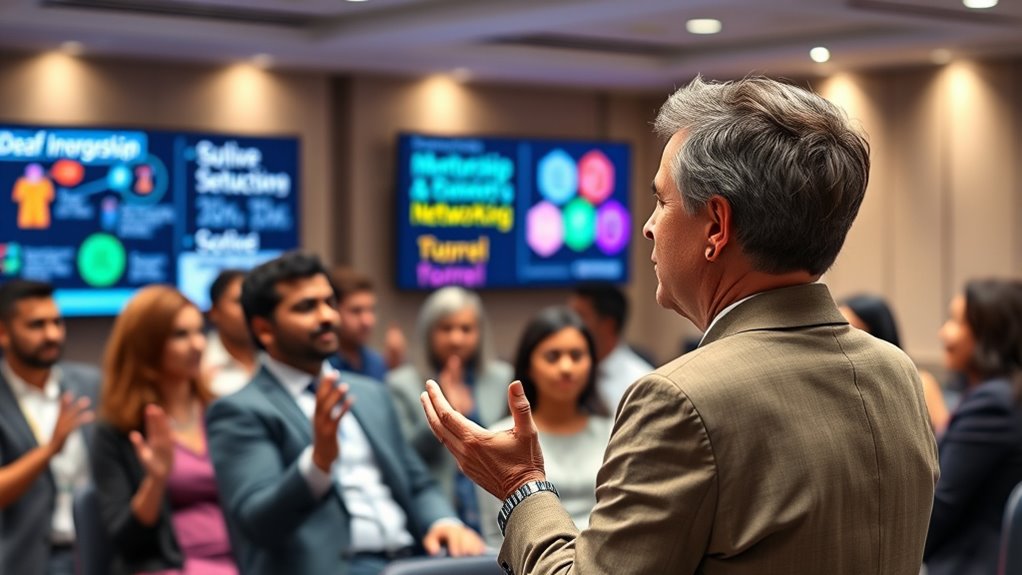
Technology has revolutionized how mentorship and networking programs connect people by making communication faster and more accessible. Assistive devices, like sign language interpreters and captioning tools, break down communication barriers. Virtual reality offers immersive experiences, enabling you to attend virtual meetups and workshops from anywhere. Here are four ways technology enhances connections:
- Real-time translation apps facilitate instant communication across languages.
- Video conferencing platforms enable face-to-face interactions remotely.
- Assistive devices improve accessibility for deaf professionals during events.
- Virtual reality creates simulated environments for networking and mentorship activities.
These innovations foster more inclusive environments, helping you build meaningful relationships regardless of physical limitations or geographical distances. Technology truly empowers deaf professionals to connect, learn, and grow in their careers.
Creating Accessible Events and Platforms
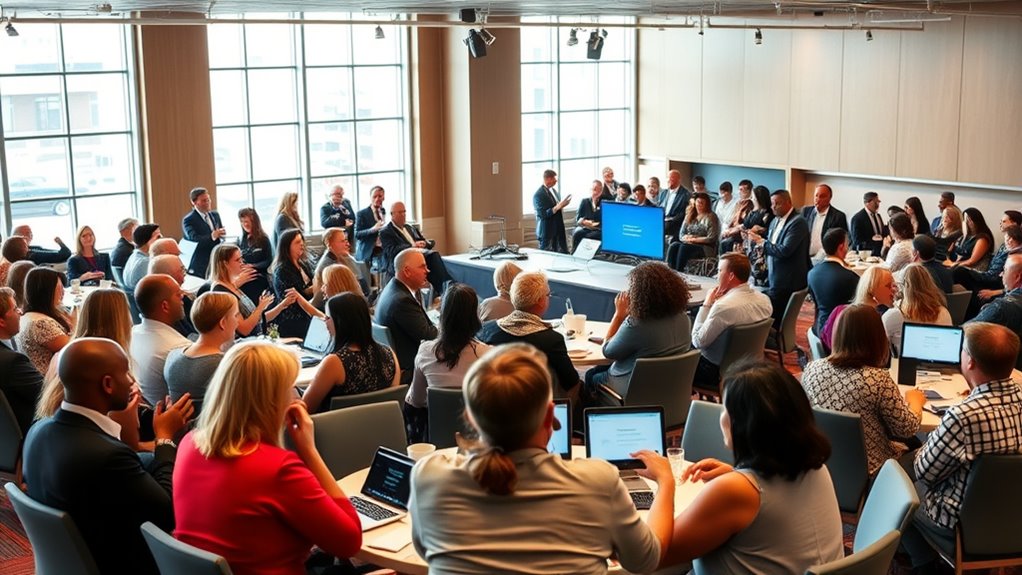
Creating accessible events and platforms is fundamental for guaranteeing that everyone can participate fully, regardless of physical or sensory limitations. Incorporating accessibility innovations, like real-time captioning, sign language interpreters, and visual aids, helps remove barriers. It’s also crucial to contemplate cultural competency—understanding and respecting diverse communication styles and cultural backgrounds. When you design events with these principles in mind, you foster inclusivity and ensure deaf professionals feel valued and engaged. Use clear signage, provide multiple communication options, and train staff to be aware of different needs. By prioritizing accessibility innovations and cultural awareness, you create environments where all participants can connect, learn, and grow without hindrance. This approach strengthens networks and promotes equitable opportunities for everyone involved.
The Impact of Peer Networks on Career Growth

Peer networks play a essential role in shaping your career growth by offering support, guidance, and opportunities for collaboration. Your peer influence helps you stay motivated, learn industry trends, and develop skills faster. Building strong professional alliances through these networks can lead to:
- Increased access to job openings and referrals
- Sharing industry insights and best practices
- Gaining emotional support during challenges
- Expanding your visibility within your field
These connections foster mutual growth, helping you navigate obstacles and seize opportunities. Peer networks encourage a sense of community, making you feel less isolated and more empowered. By actively engaging with your peers, you’ll strengthen your professional influence, enhance your reputation, and accelerate your career development.
Strategies for Effective Mentorship Engagement

To make the most of mentorship opportunities, you need to engage intentionally and proactively. Building cultural awareness helps you understand your mentor’s perspective and foster respectful, meaningful interactions. Be clear about your goals and communicate openly, ensuring your mentor understands how they can support your growth. Regular mentorship evaluation is key; assess progress and adjust your approach as needed. Seek feedback and reflect on what’s working or needs improvement. Demonstrate genuine interest and gratitude, which encourages a stronger connection. Remember, effective engagement isn’t just about receiving guidance—it’s about actively participating and respecting cultural nuances. By staying committed and mindful, you’ll create a productive mentorship relationship that advances your career and personal development.
Future Trends in Deaf Professional Development
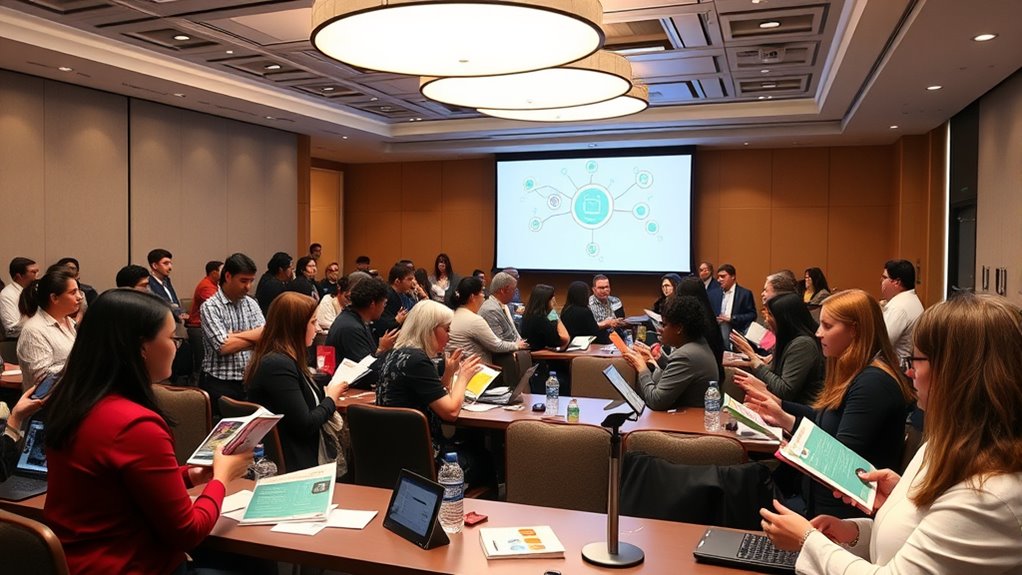
As technology continues to advance, it’s shaping the future of deaf professional development in powerful ways. You’ll see increased use of assistive technology, making communication more seamless and accessible. Additionally, organizations will prioritize cultural competency to foster inclusive workplaces. Future trends include:
- Integrating advanced assistive tech like real-time captioning and sign language apps.
- Offering specialized training to improve cultural awareness within professional settings.
- Creating virtual mentorship platforms tailored for deaf professionals.
- Promoting inclusive policies that support diverse communication styles and technological needs.
These developments empower you to connect, grow, and succeed in your career while ensuring accessibility remains central to professional growth. Embracing these trends will lead to more equitable opportunities for deaf professionals everywhere.
Frequently Asked Questions
How Do Mentorship Programs Adapt to Different Deaf Communication Preferences?
You need to recognize that each deaf person has unique communication preferences. To adapt, use sign language fluently and incorporate visual cues like gestures, facial expressions, and written text. This approach guarantees clear understanding and comfort. Programs should offer flexible communication options, including video calls or in-person meetings with interpreters. By respecting individual needs, you create an inclusive environment where all deaf professionals can thrive and connect effectively.
What Funding Sources Support Deaf Professional Networking Initiatives?
Funding for deaf professional networking initiatives is like a lifeline, providing vital support. You can explore grant opportunities from government agencies, private foundations, and nonprofit organizations dedicated to accessibility and inclusion. These funds often facilitate partnership development, helping you build strong collaborations. By actively seeking these resources, you guarantee your programs grow sustainably, empowering deaf professionals to connect, share, and thrive in their careers.
How Is Program Success Measured Within Deaf Mentorship and Networking Schemes?
When evaluating a program’s success, you focus on clear success metrics like participant engagement, skill development, and relationship building. Program evaluation involves collecting feedback, tracking progress, and measuring outcomes to see if goals are met. By analyzing these success metrics, you can determine how well the program supports deaf professionals’ growth, ensuring it effectively fosters connections and mentorship opportunities. This approach helps improve future initiatives and demonstrates impact.
What Are Common Challenges Faced by Deaf Mentors and Mentees?
You may face accessibility barriers and communication gaps that make connecting with others difficult. These challenges can hinder your ability to share experiences and learn effectively. Deaf mentors might struggle to find resources suited to their needs, while mentees may face misunderstandings or lack of clear communication. Overcoming these obstacles requires tailored strategies, such as sign language support and technology, to foster meaningful relationships and guarantee mutual understanding.
How Do Cultural Differences Influence Deaf Professional Networking Strategies?
Cultural differences considerably shape how you approach deaf professional networking. You need to recognize cultural nuances that influence communication styles, comfort levels, and relationship-building tactics. Communication barriers may arise if you overlook these nuances, leading to misunderstandings or missed opportunities. By being aware of diverse cultural perspectives, you can adapt your strategies, foster inclusivity, and create stronger connections within the deaf community and beyond.
Conclusion
Imagine mentorship and networking programs as bridges, connecting deaf professionals to new opportunities and support. By embracing these connections, you break down barriers and build a vibrant community that thrives on shared success. Stay proactive, leverage technology, and seek out inclusive platforms. As you strengthen your network, you’re not just crossing a bridge—you’re paving a path toward a brighter, more accessible future where everyone can reach their full potential.











